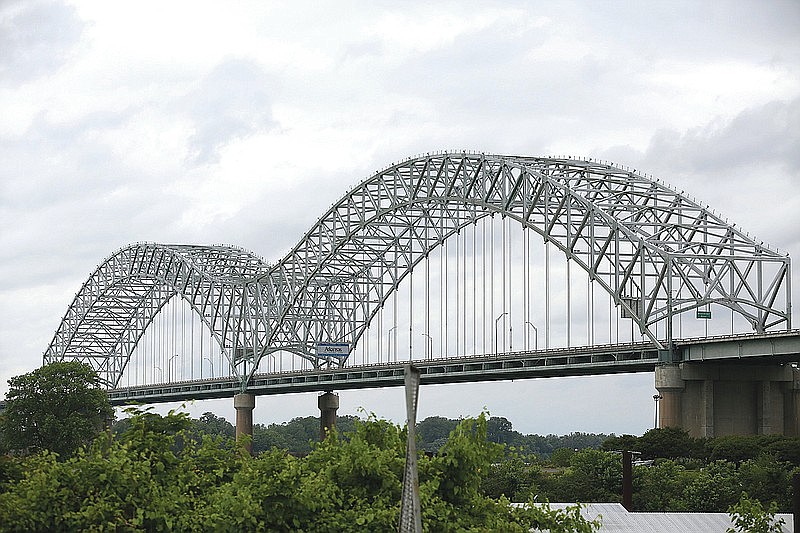Workers on Monday began removing the fractured portion of the Interstate 40 bridge over the Mississippi River, a "significant" step toward reopening the closed crossing between Arkansas and Tennessee.
Transportation officials remain mum on a concrete timeline, but they estimate the completion of repairs for the bridge could take until the end of July.
Repairs for the bridge are currently in what the Tennessee Department of Transportation calls "Phase 2," in which workers begin adding permanent steel bars and removing a section of the fractured beam.
Phase 1, which had workers install temporary steel plates to help provide stability while crews install equipment and inspect the bridge, is complete.
Phase 2, which is ongoing, will have workers add the steel bars for post-tensioning, remove the temporary steel plates, add new permanent steel plates and remove the post-tensioning steel bars.
The Tennessee Department of Transportation oversees repairs of the shared bridge, while the Arkansas Department of Transportation is responsible for bridge inspections. Kiewit Infrastructure Group was contracted to repair the bridge.
"It's just another step," said Dave Parker, a spokesman for the Arkansas Department of Transportation. "We had to get the bridge secure to work on, we did that -- or you know Kiewit and TDOT overseeing -- that was taken care of."
Repairs on the I-40 bridge began after an inspector found a crack in a steel beam on the "fracture critical" bridge, leading to immediate closure of the bridge and traffic congestion that has disrupted daily life in West Memphis and Memphis.
To explain what workers are doing to repair the bridge, Gary Prinz, an associate professor and civil engineer at the University of Arkansas, Fayetteville, likened the steel bars workers are installing to shoelaces that will be pulled to tighten the bridge together.
"Basically like tightening your shoes -- right. You pull on your two shoelaces and the center part of your shoe tightens up," Prinz said.
The crack on the Hernando de Soto Bridge, a tied-arch span, was found on a steel beam that connected chords to the arch. When the beam cracked, the load that was once carried by the beam shifted to other parts of the bridge.
"Well, once it broke it's not carrying the same amount of load," Prinz said. "Like the load got shed to other areas of the structure, likely. Like the part of the load that was carried by that [the cracked beam] is now being carried by something else."
The post-tension bars will be used to "tighten up the gap" from the crack and put the load back onto the repaired section of the bridge, Prinz said.
The crack was discovered May 11, but a photo from 2019, confirmed by transportation officials to be authentic, shows the crack has been around for potentially years. Another photo, currently being reviewed by state and federal transportation officials, appears to show a crack as far back as 2016.
The discovery led the Arkansas Department of Transportation to fire the inspection team leader for missing the crack on previous inspections.
In additions to an internal investigation, the department's bridge program is currently being reviewed by two federal agencies -- the U.S. Department of Transportation Inspector General and the Federal Highway Administration.
With repairs ongoing, drivers are instead taking the Interstate 55 bridge over the Mississippi as the only crossing from West Memphis to Memphis.
The I-40 and I-55 bridges carried a combined 85,000 t0 90,000 vehicles daily before the I-40 span's closure. The I-55 bridge has since been carrying between 75,000 and 80,000 vehicles every day. Additional traffic has detoured to bridges over the river in Helena-West Helena to the south and Caruthersville, Mo., to the north.
Traffic moved especially slow over and near the I-55 bridge in the weeks after the I-40 bridge closed, but transportation officials in both states have reported improved traffic conditions after traffic pattern changes and on- and off-ramp closures on both sides of the river.
On Monday, real-time traffic data from the Tennessee Department of Transportation said the drive time to Crump Boulevard in Memphis from the I-40/I-55 split in West Memphis took approximately nine to 12 minutes. The commute from I-55 in Memphis to the I-40 interchange in Arkansas takes about 10 to 13 minutes, according to the Tennessee Department of Transportation.
Life in the Memphis area, especially on the Arkansas side, hasn't been the same since the bridge closed.
While some commutes over the bridge can take 10 to 15 minutes depending on the time of day, during rush-hour traffic or when a wreck occurs the commute from West Memphis to Memphis can take an hour or longer.
Traffic congestion has gotten so bad at times, some ambulances in West Memphis, normally bound for hospitals right over the bridge, have been diverted to Jonesboro, about 65 miles north, and Forrest City, about 40 miles west.
Memphis is one of the key logistical hubs in the country, and the bridge closure and traffic congestion that followed has cost millions. Memphis is home to FedEx, one the largest delivery firms in the world, and Memphis International Airport, one of the busiest cargo airports in the world.
Additionally, the Arkansas Trucking Association estimates the bridge closure has cost the industry an estimated $2.4 million a day.

